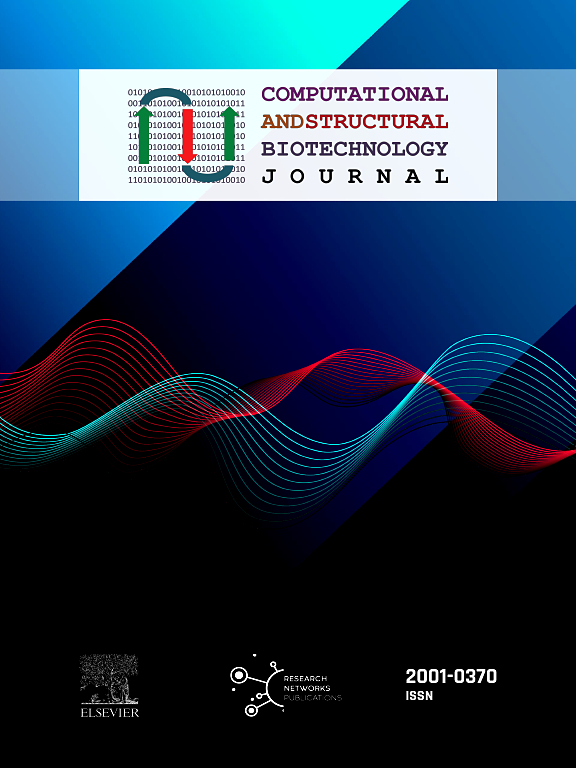Structure-based identification of HNF4α agonists: Rosmarinic acid as a promising candidate for NAFLD treatment
IF 4.4
2区 生物学
Q2 BIOCHEMISTRY & MOLECULAR BIOLOGY
Computational and structural biotechnology journal
Pub Date : 2025-01-01
DOI:10.1016/j.csbj.2024.12.014
引用次数: 0
Abstract
The prevention and treatment of metabolic disorders, such as non-alcoholic fatty liver disease (NAFLD), have emerged as critical global health challenges. Current lipid-lowering pharmacotherapies are associated with side effects, including hepatotoxicity, rhabdomyolysis, and decreased erythrocyte counts, underscoring the urgent need for safer therapeutic alternatives. Hepatocyte nuclear factor 4α (HNF4α) has been identified as a pivotal regulator of lipid metabolism, making it an attractive target for drug development. In this study, we investigated the structural characteristics and binding interactions of four HNF4α agonists: Alverine, Benfluorex, N-trans caffeoyltyramine (NCT), and N-trans feruloyltyramine (NFT). Our results indicate that the conjugated structure formed by the amide bond and the aromatic ring in NCT and NFT enhances electron density, potentially contributing to their increased specificity for HNF4α relative to Alverine and Benfluorex. Additionally, electrostatic interactions between the aromatic moieties of the compounds and HNF4α residues were found to play a crucial role in ligand binding. Leveraging these insights, we performed a high-throughput virtual screening of 2131 natural compounds, using the binding modes of NCT and NFT as reference templates. Rosmarinic acid emerged as a promising HNF4α agonist, exhibiting a high consensus score and favorable binding affinity. Subsequent biological assays demonstrated that rosmarinic acid significantly inhibited HepG2 cell proliferation which related to the enhancement of autophagy. After the knockdown of P2 isoform of HNF4α, HepG2 was more sensitive to the administration of NCT and rosmarinic acid. Furthermore, the proliferation of DLD-1 cell, which only expresses the P2 isoform of HNF4α, was not significantly inhibited by the administration of NCT and rosmarinic acid. Collectively, these findings suggest that rosmarinic acid is a promising HNF4α agonist which is more effective to activate the P1 isoform of HNF4α and holds potential as an effective treatment for NAFLD, providing a foundation for the development of novel lipid-lowering drugs with enhanced efficacy and reduced side effect.
Data Availability
Data will be made available on request.
求助全文
约1分钟内获得全文
求助全文
来源期刊

Computational and structural biotechnology journal
Biochemistry, Genetics and Molecular Biology-Biophysics
CiteScore
9.30
自引率
3.30%
发文量
540
审稿时长
6 weeks
期刊介绍:
Computational and Structural Biotechnology Journal (CSBJ) is an online gold open access journal publishing research articles and reviews after full peer review. All articles are published, without barriers to access, immediately upon acceptance. The journal places a strong emphasis on functional and mechanistic understanding of how molecular components in a biological process work together through the application of computational methods. Structural data may provide such insights, but they are not a pre-requisite for publication in the journal. Specific areas of interest include, but are not limited to:
Structure and function of proteins, nucleic acids and other macromolecules
Structure and function of multi-component complexes
Protein folding, processing and degradation
Enzymology
Computational and structural studies of plant systems
Microbial Informatics
Genomics
Proteomics
Metabolomics
Algorithms and Hypothesis in Bioinformatics
Mathematical and Theoretical Biology
Computational Chemistry and Drug Discovery
Microscopy and Molecular Imaging
Nanotechnology
Systems and Synthetic Biology
 求助内容:
求助内容: 应助结果提醒方式:
应助结果提醒方式:


